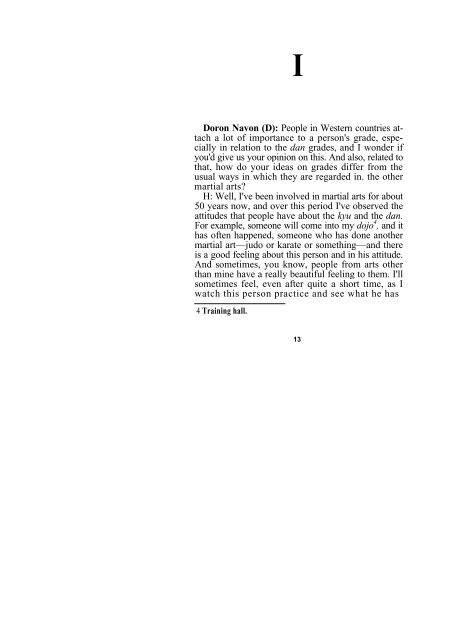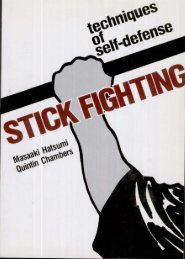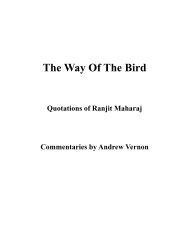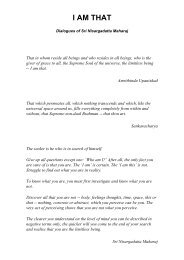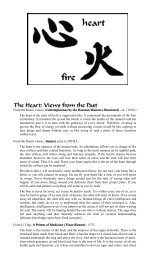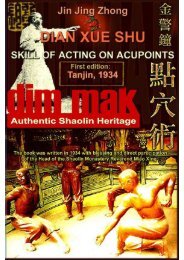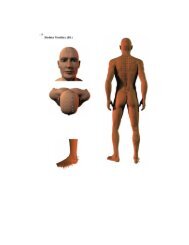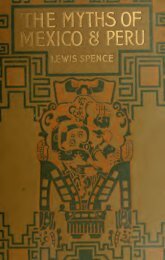Create successful ePaper yourself
Turn your PDF publications into a flip-book with our unique Google optimized e-Paper software.
14 Dr. Masaaki Hatsumi <strong>The</strong> <strong>Grandmaster's</strong> Book <strong>of</strong> <strong>Ninja</strong> Training 15<br />
brought with him from his previous <strong>training</strong>, that he<br />
is well worth a dan grade in this art. But I'm well<br />
aware that when people come from other countries<br />
and are awarded a dan grade after only a short time,<br />
they feel it's pretty strange.<br />
In my own case, I now consider that I have at last<br />
become a true Iemoto, but I believe that I received the<br />
formal recognition from my teacher, Takamatsu Sensei,<br />
very prematurely—in the same way as, in the old<br />
days, full mastership in a martial art might be conferred<br />
on a samurai even before he had attained the<br />
requisite skill. A young samurai would find a budo<br />
master who would train him in a wide variety <strong>of</strong><br />
techniques for a period <strong>of</strong> only a few days. <strong>The</strong> master<br />
would then dismiss him, saying something like,<br />
"Well, I've initiated you into the finest points <strong>of</strong> my<br />
art, and you now have all that you need from me. You<br />
are now a practitioner." <strong>The</strong> young man would then<br />
go from place to place and put what he had learned<br />
into practice in contests and so on, until he had really<br />
grasped the "feel" and "sense" <strong>of</strong> the art deeply as<br />
part <strong>of</strong> himself. Thus, it was up to him to nurture and<br />
polish his own pr<strong>of</strong>iciency and understanding.<br />
But the system <strong>of</strong> ranking people according to the<br />
skill that they have already developed is something<br />
that's tied up with sports. It's like the line that has to<br />
be crossed, for example, or the tape that must be<br />
broken, for an athlete to be acknowledged as winner,<br />
but such things do not exist when it comes to actual<br />
fighting. And the way I regard grading is free <strong>of</strong> this<br />
idea <strong>of</strong> a fixed mark.<br />
So if you take other budo like, say, karate—now,<br />
karate has its own taijutsu. It's not as if taijutsu is<br />
part <strong>of</strong> ninjutsu alone. My teacher <strong>of</strong>ten used to say<br />
that even a shopkeeper has his taijutsu—the way he<br />
bows, rubs his hands, greets his customers, and so on.<br />
And <strong>of</strong> course, dancers have their characteristic<br />
movements, their taijutsu, too, so I call our taijutsu<br />
"ninpo taijutsu," in order to distinguish it from shop<br />
keeper's taijutsu—and, for that matter, from nightclub<br />
stripper's taijutsu] And I base my dan gradings<br />
on the criteria <strong>of</strong> ninpo taijutsu.<br />
But it's when there is a misjudgment that a big<br />
problem can occur. I expect that there will be a question<br />
about that later, though, so I'll leave it for now.<br />
But one can judge a person's pr<strong>of</strong>iciency in taijutsu<br />
from the way he or she acts when holding something.<br />
It needn't be a weapon. One can even assess a grade<br />
from what happens when somebody takes a deshi, 5 or<br />
when somebody changes his or her way <strong>of</strong> life in some<br />
way. It just shows so clearly from the way a person<br />
acts. So if you give an undesirable person a stick,<br />
sooner or later he or she may well start hitting someone<br />
with it. A person's character shows itself even<br />
through a weapon. So not only taijutsu, but also<br />
bojutsu, 6 for instance, can be used to judge a person's<br />
pr<strong>of</strong>iciency in taijutsu. In very early times, they used<br />
to use wooden staffs (including the six-foot bo 7 ) for<br />
fighting—these being the equivalent <strong>of</strong> swords in the<br />
days before bronze and iron weapons existed. Later,<br />
such staffs were used when swords were unavailable.<br />
Other kinds <strong>of</strong> weapons used by the ninja were<br />
those for throwing, and a person's handling <strong>of</strong> these is<br />
equally revealing <strong>of</strong> his or her ability in taijutsu. For<br />
example, there were the shuriken, 8 and, also, onewould<br />
attach weights to a cord so as to make them fly<br />
a long way through the air for use as weapons (like<br />
the fundo <strong>of</strong> fundojutsu 9 ), and so on. <strong>The</strong>re were even<br />
esoteric techniques <strong>of</strong> "throwing one's will": achiev-<br />
5 A pupil, student, or disciple.<br />
6 A Japanese martial art using a staff as a weapon.<br />
7 <strong>The</strong> staff used for bojutsu.<br />
8 Generally star-shaped metal plates about 3" in diameter with<br />
sharpened edges. <strong>The</strong>se were thrown somewhat like a frisbee<br />
and were capable <strong>of</strong> making a very nasty, deep wound.<br />
9 Fundo is a metal weight such as may be attached to<br />
each end <strong>of</strong> a chain (or cord) for use as a weapon, employing the<br />
techniques <strong>of</strong> fundojutsu.


